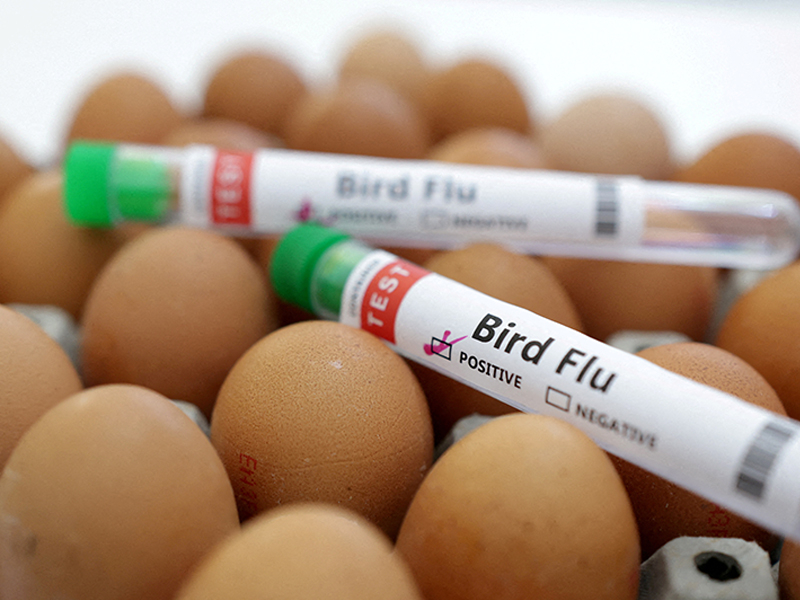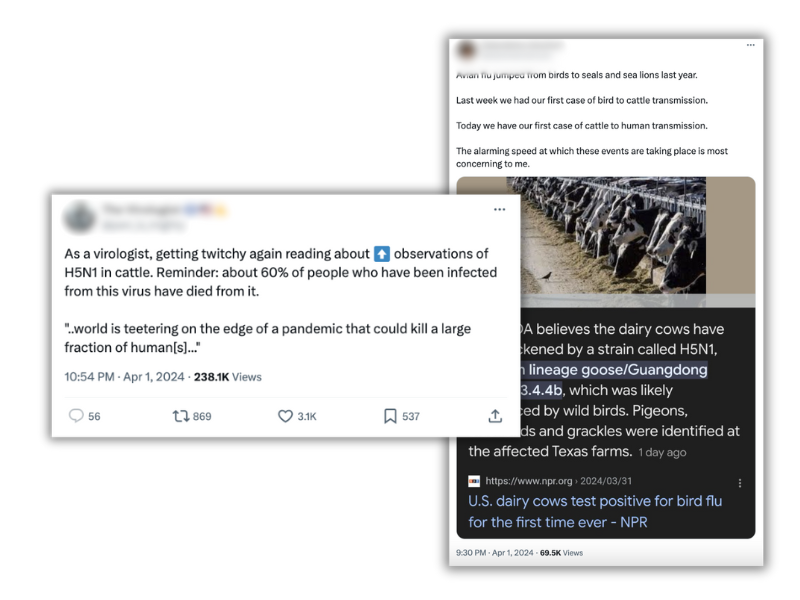By: nikolaj kristensen
April 5 2024
What are the facts about the avian influenza cases in the U.S.?

(Source: REUTERS/Dado Ruvic)
On Monday, April 1, Texas health services and the U.S. Centers for Disease Control and Prevention (CDC) reported that a person had tested positive for bird flu, also known as H5N1. The publication Science stated that the person, a farm worker, was infected after coming into contact with presumed infected dairy cattle. But should the general public be concerned?
In March, bird flu was found in multiple cattle herds in different U.S. states. This was the first time the virus had been reported in cattle, though it has previously been found in other mammals like bears, foxes, and seals. Since March 25, bird flu has affected at least 15 herds in seven different U.S. states. It is unclear how the cattle got infected, but it is likely from wild birds shedding the virus through their feces and saliva, contaminating the cow's food and water sources. The USDA's Animal Plant Health Inspection Service also said it couldn't rule out cow-to-cow transmission.
On April 2, America's largest egg production company, Cal-Maine Foods, announced it would temporarily close down production as it had found bird flu among its poultry.
Though human infection remains rare, all this bird flu-related news has sparked worry online about the virus and the potential for a new pandemic.
Bird to cattle to human
Human infection with the virus is rare, and there have only been a few reports of human-to-human transmission, and none in the U.S. The U.S. case marks only the second time a person in America has been infected with the virus. The other time was in Colorado in 2022.
The only symptom suffered by the most recent U.S. patient was eye inflammation. According to the CDC, human symptoms of H5N1 bird flu can range from mild upper respiratory symptoms to more severe illnesses like pneumonia, which has resulted in death in some countries. The CDC is monitoring the situation closely, but the recent human case has not caused them to change its human health risk assessment of the virus for the U.S. general public, which it considers to be low.
Bird flu was first discovered in humans in Hong Kong in 1997, when 18 people became infected, six of whom died. The disease had been discovered in birds in southern China only a year earlier. Since then, close to 900 human cases have been reported worldwide, and more than 460 people have died, according to the World Health Organization. The overwhelming majority of these cases occurred in the Western Pacific Region, which includes most of Asia.
In recent years, bird flu has ravaged poultry farms worldwide, with over 80 million poultry affected in the U.S. alone since January 2022.
Mandy Cohen, director of the CDC, recently told NPR that the version of bird flu that has been recorded in cattle, and that in the one human case, is the same strain previously seen in birds. This particular strain has never been seen to spread from human to human, and there is a known and effective treatment for it, the antiviral medicine Tamiflu. She also said there are even vaccine candidates ready to go and that the U.S. has been preparing for bird flu outbreaks for 20 years.
Addressing online concerns
The news about the infected person in the U.S. has stirred some alarm online, with some suggesting that the speed with which the virus has jumped from birds to different types of mammals in recent years is a cause for concern and others claiming the H5N1 virus has a mortality rate of 60 percent.
 News of bird flu cases in cattle and one human has caused concern online. (Source: X/Screenshots)
News of bird flu cases in cattle and one human has caused concern online. (Source: X/Screenshots)
James Wood, professor of infection dynamics and control of diseases at Cambridge Veterinary School, told Logically Facts that he believes there are, in general terms, good reasons to be concerned about the spread of bird flu in recent years, especially the finding of the virus transmitting in cattle.
"That the cattle transmission is happening at all should, in my view, be of concern. This is most unusual, and we should always be cautious about such things and, I think, take a precautionary approach," he said.
However, he does find some of the claims made online contestable.
"The thing about speed I would challenge. This virus (or a closely related one) has been infecting millions of birds in Europe for 3+ years now and what is in some ways surprising is that so few humans and other mammalian hosts have been infected," he said, noting the context of this virus has to be seen globally and not just from within North America.
He also said the claim about the high mortality of the virus is wrong. Though a strain of the virus that has been circulating in Asia has been associated with high mortality, this is not the case for the strain we're seeing in Europe and America.
"The clade associated with first the outbreak in Europe and then the Americas has a very low (diagnosed) human infection rate and ever lower mortality numbers," he said.
Hans Jørn Kolmos, a professor in Clinical Microbiology at the University of Southern Denmark, told Logically Facts that the jump in species to livestock herds such as mink and cattle and on to humans is "absolutely a concern," despite there still being only a few examples of humans becoming ill.
The European Centre for Disease Prevention and Control and the European Food Safety Authority recently warned that bird flu could cause "large-scale transmission" if it evolved to spread effectively among humans, due to humans lacking immune defenses to the virus.
The CDC recommends that people avoid being exposed to sick or dead animals, including wild birds and poultry, as well as animal feces, litter, or materials contaminated by birds or other animals with suspected or confirmed bird flu infection. They also advise that you do not prepare or eat uncooked or undercooked food or related uncooked food products, such as unpasteurized milk, or raw cheeses, from animals that could be or have been infected.


